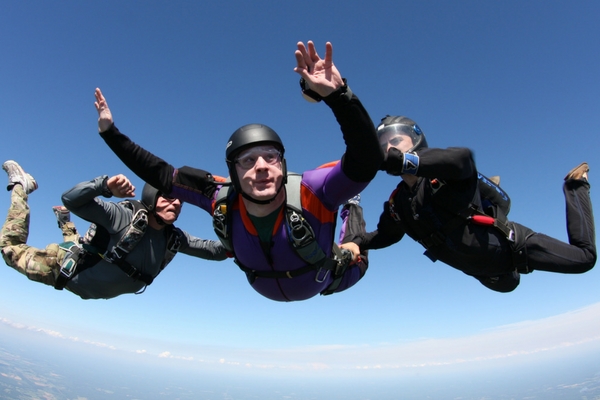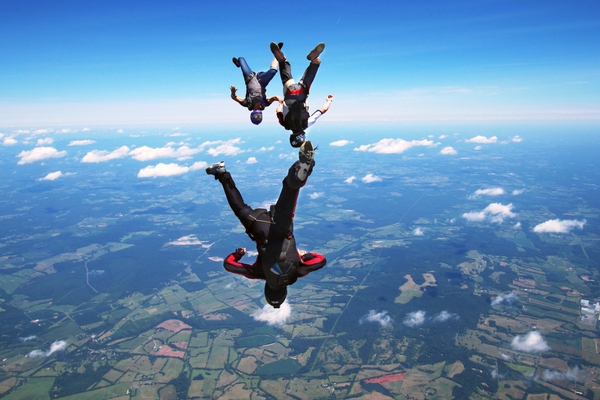How to Become Skydiver
Make no mistake about it: Becoming a licensed skydiver is a challenge. For most of us solo skydiving aficionados, however, it was the most satisfying, rewarding challenge we ever took on, and it has, in turn, led to the most satisfying, rewarding hobby we could imagine ourselves enjoying. Becoming a certified solo skydiver takes effort, commitment, resources and time, but the benefits you’ll reap will enrich your life immeasurably for many years. Seriously. No kiddin’.
If you’re truly interested in getting your skydiving license, we couldn’t be more excited to help you on the first steps of your journey. Since familiarity and forewarning help enormously, here’s a little rundown of what you can expect from the process. Bon voyage!
Start with a tandem jump.
DECIDE TO COMMIT.
You’re probably wondering the same thing everybody wonders: How much does it cost to become a certified skydiver? Since that will vary depending on the number of jumps it takes you to pass each level, we can’t give you a hard-and-fast figure. We can, however, tell you that it will indubitably be one of the best investments in yourself and your personal development that you will ever make.
To train students in its AFF skydiving program, Skydive Orange uses the USPA’s safety-oriented Integrated Student Program (ISP). The ISP curriculum was developed right here at Orange! The ISP program teaches each skydiving student the essential skills she or he will need to skydive competently. The syllabus works through a series of jumps in eight categories (A-H), each of which works toward the 25 jumps that are required in order to earn the USPA’s initial “A” skydiving license. To graduate and nail that license, you must complete 25 freefall jumps, and 19 minutes of freefall time. (Here at Orange, all student jumps are from 13,500’, except for two USPA-mandated “low solo” jumps.)
Making that initial commitment is the first round of the challenge that is skydiving certification. The moment you pick up the phone (or sit down at the keyboard) and ask us to hold your place in our certification program will feel like a skydive in itself–scary, exciting and full of possibility. Enjoy the significance of it!
COMPLETE YOUR FIRST JUMP COURSE.
You’ll begin your solo skydiving education with a classroom-based First Jump Course. This classroom time lasts about 6-8 hours of thorough on-the-ground training and a written test. During “skydiving school,” you’ll learn a little about the history of the sport, about the equipment, about the different types of malfunctions and about our skydiving procedures (especially the ones we use in case of emergencies).
GET YOUR FIRST JUMP DONE AND DUSTED.
The first AFF jump is a landmark moment for everyone. Sure, you’ll have two instructors holding on to you until deployment time, but it’s still a toe-tingling challenge to face off with those nerves. Make sure to show up well-rested, nourished, hydrated and stretched because you’ll have your work cut out for you!
Weather permitting, you’ll make your first jump on the same day as your ground school. For that first jump, you’ll leave the plane with two instructors holding securely on to special handles sewn into your jumpsuit. This first jump is a getting-to-know-you affair between you and the sky: It’s about getting acclimated to the sensations of freefall, to altitude awareness, to a stable freefall body position, and to that eventual parachute deployment). You can expect your instructor to hang on right up until s/he has witnessed you deploy your parachute. From there, you’ll listen to ground-crew guidance on the radio to help you navigate safely down to the landing area.
After your landing (and the resultant flurry of giddy high-fives), your instructors will sit down with you to talk about your jump. This first “debrief” will get you set up for the next steps.

WORK YOUR WAY DOWN THE “TO-DO” LIST.
From there, you’ll pass the remaining seven levels of the course. You’ll demonstrate to your instructor(s) that you can safely and stably exit the plane, fall in a stable configuration and stay aware of your heading and altitude. You’ll refine your body position, learn how to control your degree of turn, move close to and away from other jumpers in the sky and execute barrel rolls, front flips and backflips. Finally, of course, you’ll demonstrate those all-important “canopy skills,” proving that you can safely control and navigate your very own parachute using a variety of inputs.
It may sound like a lot to tackle–and it is–but it’s a boiled-down checklist of absolutely necessary skills. You’ll need to demonstrate your mastery of these essentials before your instructor signs off on your completion of the the AFF course.
TAKE ON THE NEXT STEPS.
Once you have that USPA A license in hand, you’ll be primed and ready to tackle the next steps. The more advanced skydiving certification levels–the B, C and D licenses–will move you well into your skydiving career, and the ratings you can earn will allow you to do demonstration jumps, participate in incredible airsports events and even teach new jumpers how to skydive. With time, effort and dedication, you can even become a certified skydiver instructor. (For more on this, check out the USPA’s website.)

GET STARTED. (TODAY!)
Your AFF first jump course must be scheduled in advance, so get on it! Please contact us to discuss available course dates. View our pricing packages and call us today to book your class!
Please note: You MUST be at least 18 years of age to jump and under 225 lbs. No exceptions!



0 Comments